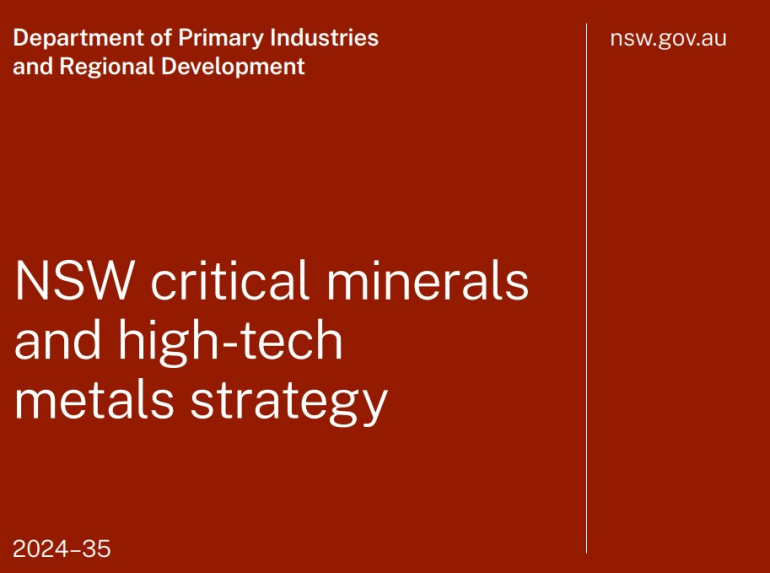Latest news
Read the latest news from the Centre for Sustainable Materials Research and Technology

The UNSW SMaRT Centre contributed to the NSW Government's newly released Critical Minerals and High-Tech Metals Strategy 2024-35.
Key points from SMaRT's submission are reflected through the new strategy, and were also included in as expert input to the submission by the Australian Academy of Technological Sciences & Engineering.
Key points included in the new Strategy:
Page 15: Australia already faces a significant e-waste challenge and in the future this will be compounded by vast quantities of solar panels and electric vehicle and energy storage batteries reaching their end-of-life and entering a waste disposal stream. Despite e-waste and renewable energy technologies containing valuable materials such as gold, copper, cobalt, lithium and palladium, only a small fraction is recycled. NSW already has the highest global per capita rate of household solar panels (with the lifespan of these limited to around 10–15 years) and in future will host the greatest volume of spent battery material in Australia, with uptake of batteries in the national electricity market expected to increase significantly. To date, end-of-life phases of the solar/battery supply chain have been under-invested compared to both expected growing demand for components and waste disposal challenges, which presents a market failure requiring government intervention. Developing industrial-scale critical minerals recycling could present new market opportunities in NSW.
Page 28: Integrating the critical minerals sector into the wider value chain strengthens our market position and ensures a more resilient and sustainable supply chain. NSW also has an opportunity to focus on critical minerals recovery from e-waste recycling. With the highest global per capita rate of household solar panel installations and the largest forecasted volume of spent battery materials in Australia, NSW is uniquely positioned to leverage these challenges into opportunities. The recovery and recycling of critical minerals from e-waste, spent batteries, and solar panels not only offers avenues to broaden the critical minerals industry but also support sustainable manufacturing practices by reducing waste to landfill. The state’s existing strengths in research and innovation form a solid foundation that could be leveraged to support the growth of our capability. Partnerships across government, industry and academia could drive further research and development and support local commercialisation.
Page 28: During consultation, stakeholders emphasised the need to invest in innovation, research, and development in NSW, whilst focusing on leveraging existing expertise for innovation in mining, processing and recycling technologies. Stakeholders raised interest in forming partnerships with research institutions and universities to enhance research and development capabilities. The potential for government support in research and development, particularly for downstream processing and recycling initiatives, was noted as vital for creating new markets and jobs.
Page 28: What we will do:
Extract from the ATSE submission:
Future activity in NSW may include industry-led exploration and mining of promising deposits including cobalt, antimony, lithium, and rare earth elements. As other Australian states have more extensive critical mineral deposits, there is an opportunity for NSW to focus on developing mining and processing technologies that could be utilised in partnership with other states. The Strategy can support technology development and deployment, supplementing industry initiatives.
The Strategy can enhance the role of waste as a resource. E-waste and mining by-products represent significant sources of metals and other essential materials for a net zero future. The Strategy can support research, development and roll-out of recycling technologies, which can often be set up in regional areas. Locally developed technologies include the MICROfactorie, created by ATSE Fellow, Scientia Professor Veena Sahajwalla, which can recover resources from waste to create new value-added products. New technologies from overseas are also investment opportunities such as HyProMag used in rare earth magnetic recycling.
Delivery of the Strategy will require a skilled workforce for discovery, extraction, and sustainable processing, as well as recovery and recycling, and manufacturing of net zero technologies such as batteries, solar cells and turbines. These will require skills and training in resource and economic assessment, chemical and mining engineering, mineral
separation and concentration, hydrometallurgy, pyrometallurgy, and plant operation. Developing these skills is particularly crucial given their broad applicability to other aspects of the green energy transition and development of resilient infrastructure. ATSE agrees with the Strategy’s proposed focus on developing skills and training to support the workforce: we have considerable expertise in this space and would welcome the opportunity to further assist the New South Wales Government in the development of an appropriate roadmap for skilled workforce development.
We note that universities are absent from the previous Strategy, despite housing the programs essential to the mining industry and supporting the industry through technology development. Federal policy has reduced the profitability of these programs. With declining enrolments, universities are discontinuing courses such as geology, geography and metallurgy. Graduates of these programs will be vital to realise the benefits of Australia’s critical mineral deposits. To be successful, the Strategy must highlight the role of universities and support their ability to deliver appropriate training. Research and development, including in recycling, and a highly skilled workforce will be imperative to supporting a minerals industry that contributes to Australia’s net zero ambitions.